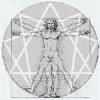“For this purpose a man must learn to take, so to speak, ‘mental photographs’ of himself at different moments of his life and in different emotional states: and not photographs of details, but photographs of the whole as he saw it. In other words these photographs must contain simultaneously everything that a man can see in himself at a given moment. Emotions, moods, thoughts, sensations, postures, movements, TONES of voice, facial expressions, and so on. If a man succeeds in seizing interesting moments for these photographs he will very soon collect a whole album of pictures of himself which, taken together, will show him quite clearly what he is. But it is not so easy to learn how to take these photographs at the most interesting and characteristic moments, how to catch characteristic postures, characteristic facial expressions, characteristic emotions, and characteristic thoughts. If the photographs are taken successfully and if there is a sufficient number of them, a man will see that his usual conception of himself, with which he has lived from year to year, is very far from reality. Fragments: Eight
“This same process of the harmonious development of man can be examined from the point of view of the law of octaves. The law of octaves gives another system of symbols. In the sense of the law of octaves every completed process is a transition of the note do through a series of successive TONES to the do of the next octave. The seven fundamental TONES of the octave express the law of seven. The addition to it of the do of the next octave, that is to say, the crowning of the process, gives the eighth step. The seven fundamental TONES together with the two ‘intervals’ and ‘additional shocks’ give nine steps. By incorporating in it the do of the next octave we have ten steps. The last, the tenth, step is the end of the preceding and the beginning of the next cycle. In this way the law of octaves and the process of development it expresses, include the numbers 1 to 10. At this point we come to what may be termed the symbolism of numbers. The symbolism of numbers cannot be understood without the law of octaves or without a clear conception of how octaves are expressed in the decimal system and vice versa. Fragments: Fourteen
“The octave possesses seven TONES and the eighth is a repetition of the first. Together with the two ‘additional shocks’ which fill the ‘intervals’ mi-fa and si-do, there are nine elements. Fragments: Fourteen

